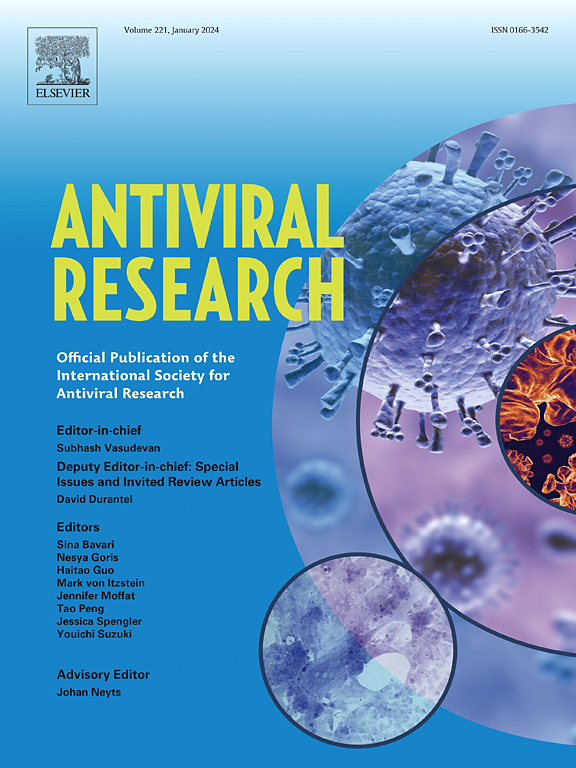刺突蛋白S2结构域的融合肽可能是β-冠状病毒的模拟物,可能是一种新型病毒-宿主膜融合抑制剂。
IF 4.5
2区 医学
Q1 PHARMACOLOGY & PHARMACY
引用次数: 0
摘要
冠状病毒最近引起了更多的关注,特别是在2019年大流行之后。冠状病毒科β属已证明对人类构成重大威胁。目前的缓解战略包括开发疫苗和重新利用药物来对症处理冠状病毒感染,特别是SARS-Cov 2。作为冠状病毒抗病毒药物可用的融合抑制剂针对刺突蛋白S2结构域的七磷酸重复序列(HR) 1和2。目前的研究确定了HR1上游的融合肽(FP)作为开发膜融合抑制剂的潜在靶点,并测试了类似FP片段的模拟肽的抗病毒活性。研究了4种模拟融合肽(RSA59PP (MFP633)、RSA59P (MFP634)、RSMHV2P (MFP635)和RSMHV2PP (MFP636)),它们与小鼠β冠状病毒小鼠肝炎病毒(MHV)、MHV- a59 /RSA59 (PP)和MHV-2/RSMHV2 (P)具有中心脯氨酸突变的FP相似。结果表明,mfp能够在体外减少细胞间融合和病毒复制。含有中心双脯氨酸的MFP633在刺突蛋白介导的膜融合实验中表现出最有效的抑制作用。生物物理实验也证明了含双脯氨酸的mfp (MFP633和MFP636)与仿生脂质体之间的相互作用最强。使用脂质体介导的小鼠体内传递系统的体内研究证实了MFP633的抗病毒活性。这些发现表明,针对FPs可以开发出有效的冠状病毒融合抑制剂。在宿主-病毒膜融合事件的早期阶段,mfp通过与病毒FP竞争作用于宿主细胞膜。MFP633是一种很有前景的候选多肽药物,值得进一步研究,以评估该多肽和其他双脯氨酸肽是否可以在其他具有保守FP结构的冠状病毒中发挥类似的抗病毒作用。本文章由计算机程序翻译,如有差异,请以英文原文为准。
The fusion peptide of the spike protein S2 domain may be a mimetic analog of β-coronaviruses and serve as a novel virus-host membrane fusion inhibitor
Coronavirus has garnered more attention recently, particularly in the aftermath of the 2019 pandemic. The β genus of the coronavirus family has demonstrated a significant threat to humanity. Current mitigation strategies involve the development of vaccines and repurposing drugs for symptomatic management of coronavirus infection, specifically SARS-Cov 2. Fusion inhibitors that are available as antiviral drugs for coronavirus have targeted the heptad repeat (HR) 1 and 2 in the S2 domain of the spike protein. The current study identified a fusion peptide (FP) upstream of HR1 as a potential target for developing membrane fusion inhibitors, and mimetic peptides analogous to the FP segment were tested for antiviral activity. Four mimetic fusion peptides (MFPs) (RSA59PP (MFP633), RSA59P (MFP634), RSMHV2P (MFP635), and RSMHV2PP (MFP636)) that are analogous to the FP of murine β coronavirus mouse hepatitis virus (MHV), MHV-A59/RSA59 (PP) and MHV-2/RSMHV2 (P) with central proline mutations, were tested. Results show the ability of MFPs to reduce cell-to-cell fusion and viral replication in vitro. MFP633, which contains a central double proline, exhibited the most potent inhibitory effect in spike protein-mediated membrane fusion assays. Biophysical experiments also demonstrated the strongest interactions between double-proline containing MFPs (MFP633 and MFP636) with biomimetic liposomes. In vivo studies using a liposome-mediated delivery system in mice confirmed the antiviral activity of MFP633. These findings suggest that targeting FPs could develop effective fusion inhibitors against coronaviruses. MFPs act on the host cell membrane by competing with the viral FP during the early stage of host-viral membrane fusion events. MFP633 is a promising peptide drug candidate that warrants future examination to assess whether this and other dual-proline containing peptides may exert similar anti-viral effects in other coronaviruses with conserved FP structures.
求助全文
通过发布文献求助,成功后即可免费获取论文全文。
去求助
来源期刊

Antiviral research
医学-病毒学
CiteScore
17.10
自引率
3.90%
发文量
157
审稿时长
34 days
期刊介绍:
Antiviral Research is a journal that focuses on various aspects of controlling viral infections in both humans and animals. It is a platform for publishing research reports, short communications, review articles, and commentaries. The journal covers a wide range of topics including antiviral drugs, antibodies, and host-response modifiers. These topics encompass their synthesis, in vitro and in vivo testing, as well as mechanisms of action. Additionally, the journal also publishes studies on the development of new or improved vaccines against viral infections in humans. It delves into assessing the safety of drugs and vaccines, tracking the evolution of drug or vaccine-resistant viruses, and developing effective countermeasures. Another area of interest includes the identification and validation of new drug targets. The journal further explores laboratory animal models of viral diseases, investigates the pathogenesis of viral diseases, and examines the mechanisms by which viruses avoid host immune responses.
 求助内容:
求助内容: 应助结果提醒方式:
应助结果提醒方式:


